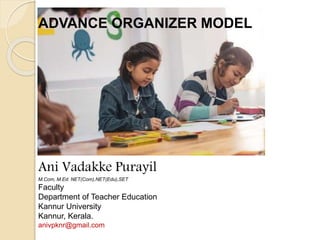
Advance Organizer Model Explained
- 1. ADVANCE ORGANIZER MODEL Ani Vadakke Purayil M.Com, M.Ed. NET(Com),NET(Edu),SET Faculty Department of Teacher Education Kannur University Kannur, Kerala. anivpknr@gmail.com
- 2. Models of Teaching include many but not all of the major philosophical and psychological orientations towards teaching and learning. Each of them has coherent theoretical bases (Joyce and Weil, 1972). A model of teaching consists of guidelines for designing educational activities and environment. It specifies ways of teaching and learning that are intended to achieve certain kinds of goals. The use of models requires an ability to identify different types of Instructional goals so that specific model can be selected to match a particular goal. A teaching model can be Models of Teaching(Eggen, Kauchak and Harder, 1979).
- 3. ADVANCE ORGANIZER MODEL An advance organizer is a tool used to introduce the lesson topic and illustrate the relationship between what the students are about to learn and the information they have already learned. They are used during expository instruction, which is the use of an expert to present information in a way that makes it easy for students to make connections from one concept to the next. By using an advance organizer to link the new information to old information, the new information can be remembered more
- 4. There are three basic purposes of advance organizers. First, they direct students' attention to what is important in the upcoming lesson. Second, they highlight relationships among ideas that will be presented. Third, they remind students of relevant information that they already have.
- 5. Advance Organizer Model is based upon the Learning Theory of Meaningful Verbal Learning formulated by David P Ausubel. The theory of Meaningful Verbal Learning applies to situation where the teacher plays the role of lecturer or explainer. The main purpose is to help students acquire subject matter. To facilitate both stability and meaning, one needs to create ideational linkage between the students’ own cognitive structure and that of the discipline to be taught.
- 6. Ausubel uses two principles to organize curriculum and instruction: progressive differentiation and integrative reconciliation. . Progressive differentiation refers to the most general ideas of the discipline presented first followed by a gradual increase in details and specificity. When subject matter is programmed in accordance with the principle of progressive differentiation the most general and inclusive ideas of a discipline are presented first and progressively differentiated in terms of detail and specificity.
- 7. Integrative reconciliation refers to the practice of interrelating or cross referencing these units or ideas so that significant similarities and differences are recognized and real or apparent inconsistencies are reconciled. Integrative reconciliation simply means that new ideas should be consciously related to previously learned content. In integrative reconciliation, teacher attempts to make the logical relationship between ideas in the developing schema apparent to students. There are two types of integrative
- 8. Vertical reconciliation explores relationship between more and less abstract ideas and is designed to insure that new ideas between attached to old in a hierarchical fashion. Horizontal reconciliation investigates similarities and differences between coordinate concepts and other ideas at a similar level of abstraction.
- 9. Syntax of the Model Phase one Presentation of Advance Organizer Clarify aims of the lesson. Present organizer:- Identify defining attributes Give examples Provide context Repeat Prompt awareness of learner’s relevant knowledge and experience.
- 10. Phase two Presentation of learning Task or Material Present material. Maintain attention. Make organization explicit. Make logical order of learning material explicit.
- 11. Phase three Strengthening Cognitive organization Use principles of integrative reconciliation. Promote active reception learning. Elicit critical approach to subject matter. Clarify.
- 12. Social System: The social system is a structured one. The teacher is the initiator and the controller of norms. Beyond the presentations of the organizer the learning situation assume a less structured posture and teacher and students can be very interactive. Principles of Reaction:- The teacher or the Instructional material controls the situation. The content has been selected for the learner, and the teacher should facilitate the discussion around the material at hand. Mutual interaction between teacher and learner responsively connect organizers and learning material.
- 13. Support System:- Well-organized material is critical. The effectiveness of Advance Organizer depends on an integral relationship between the conceptual organizer and the rest of the content. The model provides guidelines for building or reorganizing Instructional materials. Instructional and Nurturant Effects: The instrumental values of this model are – the ideas themselves that are used as the organizer are learned, as well as information presented to the students.
